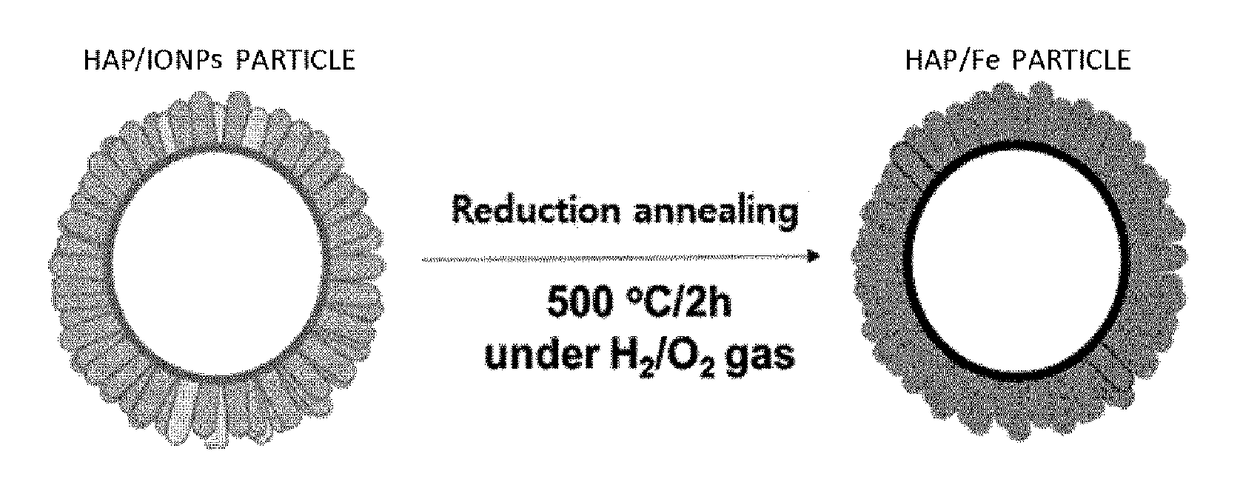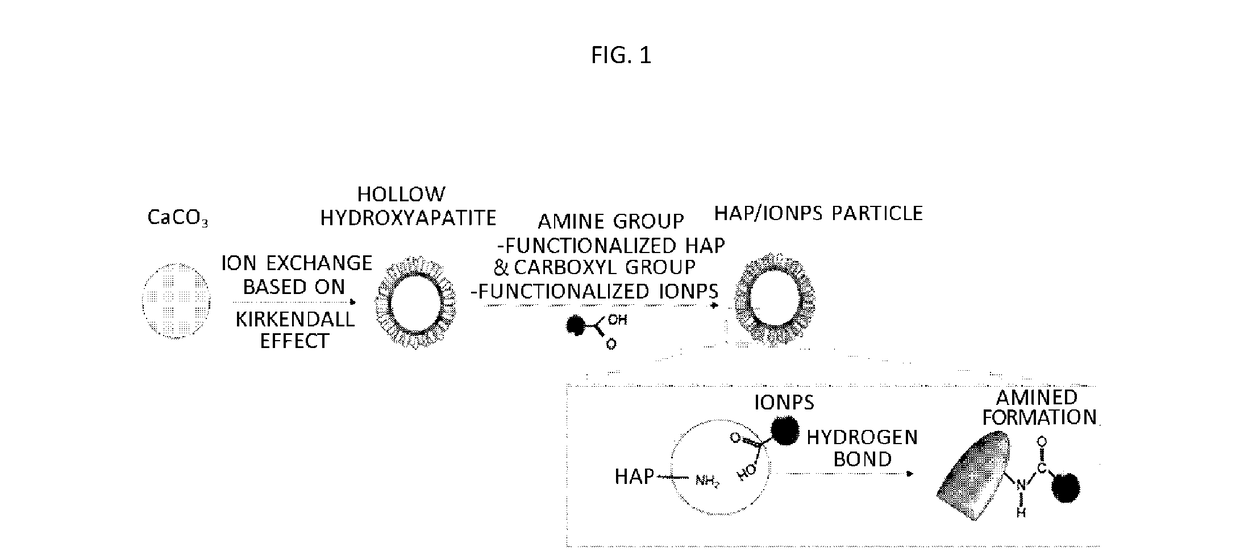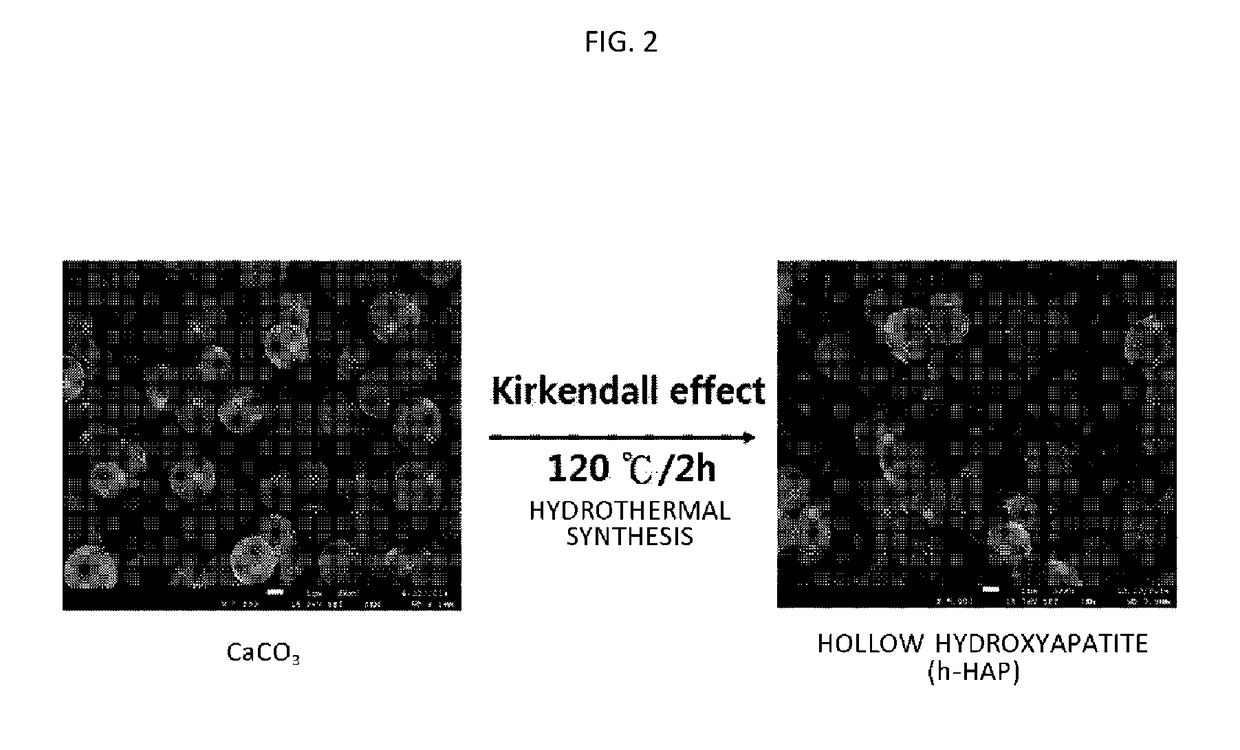Composites for removing heavy metal and method of synthesizing the same
a technology of heavy metals and compounds, applied in the field of compounds for removing heavy metals, can solve the problems of human and ecosystem, the above-described solidification cannot be a fundamental solution to heavy metal contamination, and the biological treatment method takes a long time to be treated, so as to improve the adsorption efficiency of heavy metals, improve the adsorption efficiency, and facilitate the removal of heavy metal adsorbing particles.
- Summary
- Abstract
- Description
- Claims
- Application Information
AI Technical Summary
Benefits of technology
Problems solved by technology
Method used
Image
Examples
example 1
Synthesis of Hollow Hydroxyapatite Particles
[0076]A composite of hydroxyapatite and iron of the present disclosure was synthesized by a method as shown in FIG. 1. Specifically, spherical calcium carbonate (CaCO3) particles were prepared first and hollow hydroxyapatite (HAP) particles were prepared using a Kirkendall effect. The spherical calcium carbonate particles were prepared using a fast precipitation method.
[0077]A first solution was prepared by mixing 0.472 g of calcium nitrate (Ca(NO3)2) in 20 ml of a 25 g / L polystyrene sulfonate (PSS) solution, and a second solution was prepared by dissolving 0.212 g of sodium carbonate (Na2CO3) in 5 ml of deionized water.
[0078]Each solution was completely dissolved and then, the second solution was added into the first solution and then briskly mixed for 30 minutes, followed by centrifugation to obtain a resultant product.
[0079]30 ml of a 0.5 M disodium hydrogen phosphate (Na2HPO4) aqueous solution was mixed with the obtained product and a ...
example 2
Synthesis of Composite of Hollow Hydroxyapatite and Iron Oxide Nanoparticle
[0081]A composite of hydroxyapatite and iron oxide nanoparticles (HAP / IONPs) was synthesized through a surface treatment to each of hollow HAP and iron oxide nanoparticles.
[0082]Specifically, in order to form an amine group on surfaces of the HAP particles synthesized in Example 1, 0.1 g of the HAP particles and 2 ml of (3-aminopropyl)trimethoxysilane were put into 10 ml of ethanol and mixed therein and then mixed in a 70° C. oil reactor for 3 hours. After the reaction, a resultant product was washed with ethanol and dried in a vacuum oven.
[0083]In order to form a carboxyl group on surfaces of iron oxide nanoparticles (IONPs), 5 ml of IONPs dispersed in hexane at a concentration of 1 mg / ml was put into 5 ml of DMSO in which citric acid was dispersed at a concentration of 10 mg / ml and then briskly mixed and reacted in a 70° C. oil reactor for 3 hours. After the reaction, oleic acid and citric acid which remain...
example 3
Synthesis of Composite of Hydroxyapatite and Iron (HAP / Fe)
[0084]As shown in FIG. 3, annealing was carried out in an alumina tube furnace using the following conditions to form a composite of HAP and Fe by reducing the HAP and the iron oxide nanoparticles. Reduction annealing was performed to the dried composite of HAP and IONPs synthesized in Example 2 at 500° C. for 2 hours under an atmosphere of a H2 / N2 mixture gas.
PUM
| Property | Measurement | Unit |
|---|---|---|
| pH | aaaaa | aaaaa |
| pH | aaaaa | aaaaa |
| pH | aaaaa | aaaaa |
Abstract
Description
Claims
Application Information
 Login to View More
Login to View More - R&D
- Intellectual Property
- Life Sciences
- Materials
- Tech Scout
- Unparalleled Data Quality
- Higher Quality Content
- 60% Fewer Hallucinations
Browse by: Latest US Patents, China's latest patents, Technical Efficacy Thesaurus, Application Domain, Technology Topic, Popular Technical Reports.
© 2025 PatSnap. All rights reserved.Legal|Privacy policy|Modern Slavery Act Transparency Statement|Sitemap|About US| Contact US: help@patsnap.com



